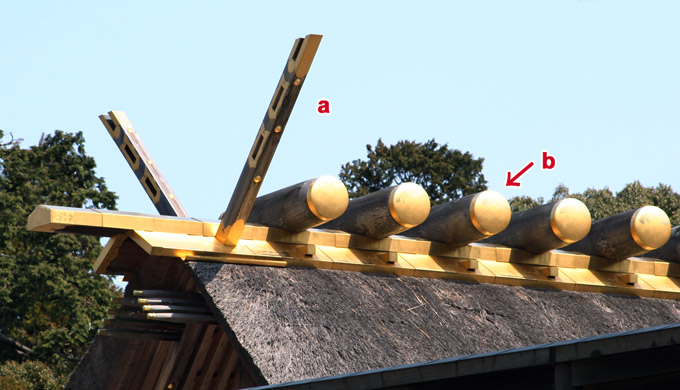Also
written 鰹木, 勝男木, 葛緒木. Also called kasoegi 斗木. Wooden billets placed atop
and at right angle to a roof ridge, especially in shrine and palace architecture.
The KOJIKI 古事記, in the entry concerning the history of Emperor Yuuryaku's
雄略 (reign 456-79), states that the Emperor saw "a house built with raised logs
on its roof," and was furious, calling the owner a scoundrel for building a house
like his palace. Thus it would seem that at this early date, katsuogi were
used only on the Emperor's palace. By the 6c, along with forked finials *chigi
千木, billets were used on the roofs of homes belonging to powerful families. It
is possible that originally they were used to weight down the thatch and therefore
played a significant structural role. As the practical need for katsuogi
diminished they became merely decorative and symbolic. It can also be presumed
that permission to use them was extended to Shinto shrines because of the Emperor's
descent from the Sun Goddess, Amaterasu Oomikami 天照大神. The Nakatomi 中臣 and Mononobe
物部 families, ardent Shinto supporters, who were appointed by the Emperor to care
for shrines and shrine functions, were also eventually permitted to have billets
placed on the ridges of their homes. The billets varied in number, with at least
one at each end, generally placed behind the forked finials. At Ise Jinguu 伊勢神宮
ten katsuogi were placed on the main sanctuary *Shouden 正殿 of the Inner
Shrine, Naikuu 内宮, and nine on the main sanctuary of the Outer Shrine, Gekuu 外宮.
Usually billets are circular and slightly tapered at each end. In high ranking
shrines, decorative gold plated copper or bronze covers are placed over the billet
ends to protect them from weathering. However, there are some exceptions, such
as the angular katsuogi at Sumiyoshi Taisha *Honden 住吉大社本殿 in Osaka, or
the double pairs of square ones placed on the rear half of the ridge at Yoshida
Jinja 吉田神社 Octagonal Hall called Taigenguu 太元宮, in Kyoto. Katsuogi are
always used on the ridges of buildings in *shinmei-zukuri
神明造, *kasuga-zukuri
春日造, *sumiyoshi-zukuri
住吉造, and *taisha-zukuri
大社造. More rarely, they are seen on main sanctuaries built in other styles.
|



